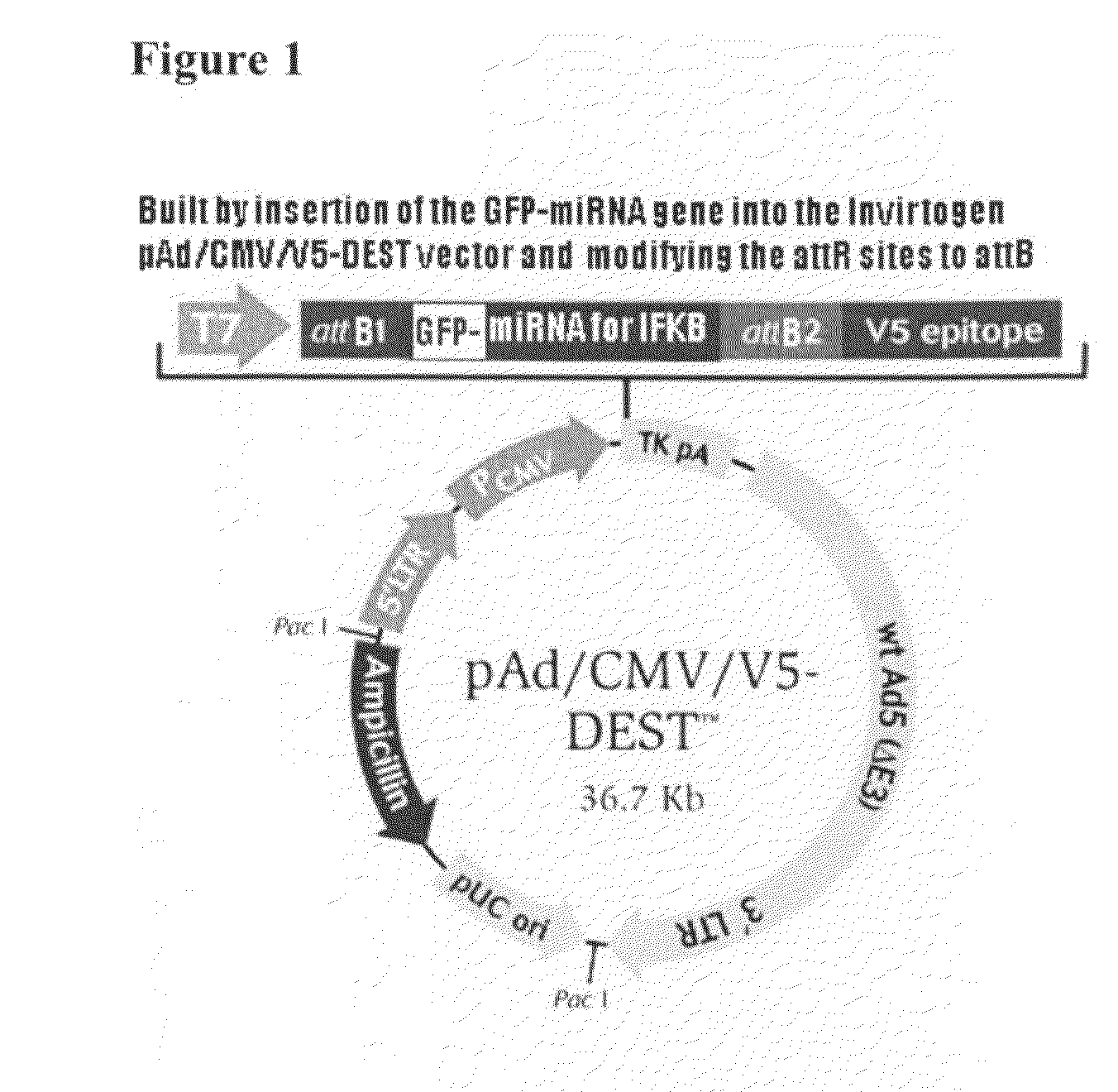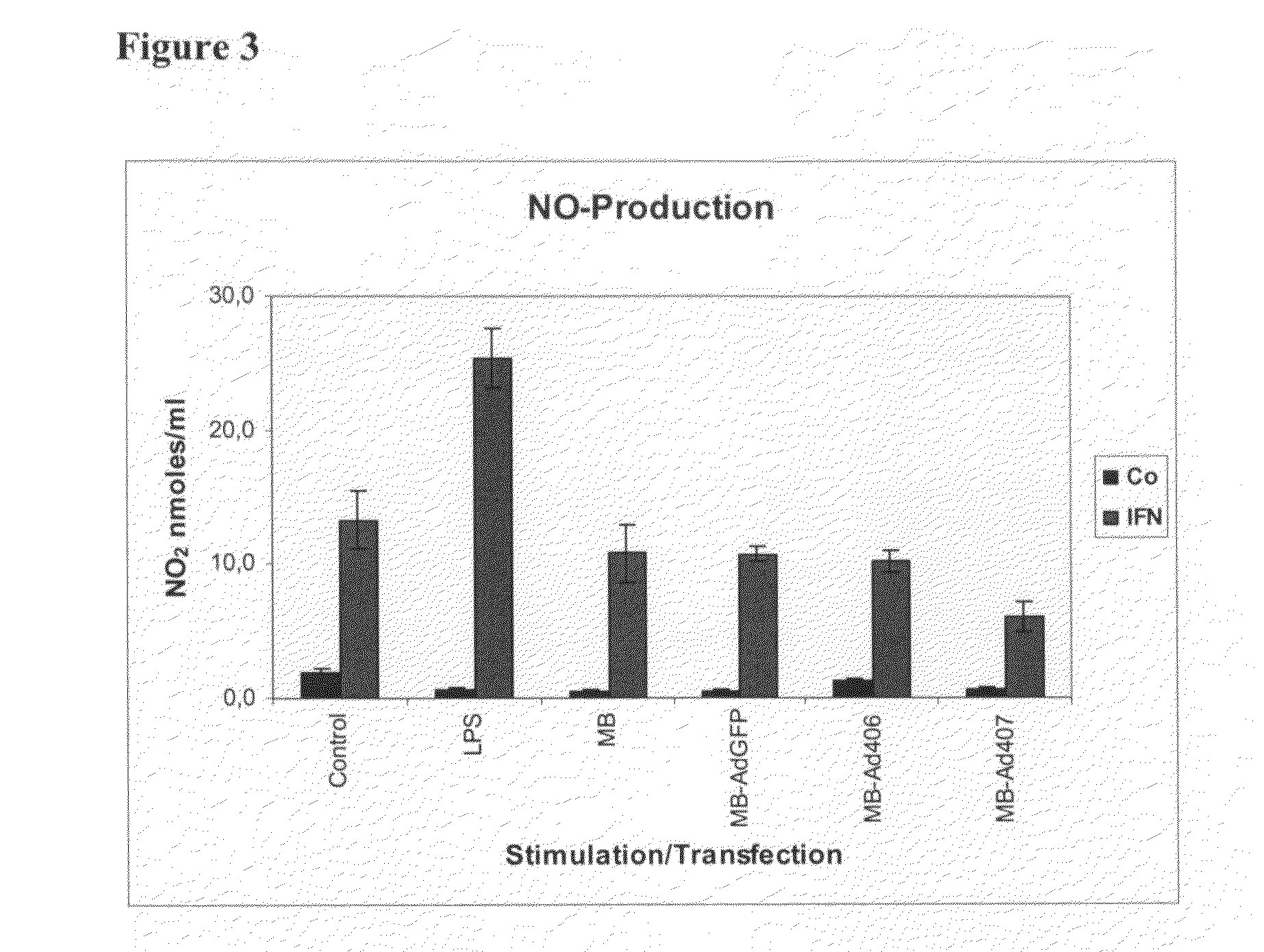Activation of nuclear factor kappa B
a nuclear factor and kappa technology, applied in the field of targeted activation of nuclear factor kappa b, can solve the problems of patient death, negative effect of activation of nfb,
- Summary
- Abstract
- Description
- Claims
- Application Information
AI Technical Summary
Problems solved by technology
Method used
Image
Examples
example 1
[0059]This example demonstrates the construction of siRNA for IκB. (Equal amounts of top and bottom strand miR oligos were annealed to generate double stranded oligos. The ds oligos were then ligated into linearized pcDNA6.2-GW / EmGFP-miR and transformed into One Shot TOP10 competent cells. Transformants were picked and plasmid DNA sequenced for confirmation of insertion of the miR ds oligo in the vector. The new vector was named pcDNA6.2-GW / EmGFP-miR IkB.
[0060]The newly generated pcDNA6.2-GW / EmGFP-miR IkB vector was linearized by Sac I digestion and purified. A BP recombination reaction was performed between the linearized vector and the donor vector pDONR221. 1 ul of the BP reaction was used to transform the TOP10 competent cells and correct transformants were selected by restriction enzyme digestion of the plasmid DNA. The plasmids at this step were named entry clones.
[0061]The correct entry clone was then used together with a destination vector pAd / CMV / V5-DEST in a LP recombinati...
example 2
[0062]This example demonstrates stimulation of macrophage anti-tumor activity by adenovirus-mediated gene transfer.
[0063]Thioglycollate elicted mouse peritoneal macrophages were transfected with Ad-MB-vectors at a ratio of approximately 4 magnetic beads (equivalent to about 40 Ad-particles) per macrophage for 16 hours, either with or without additional stimulation with interferon (IFN)-γ. Thereafter, culture medium was replaced by fresh medium without stimulants and YAC-1 mouse lymphoma cells added at an effector to target ratio of 10:1. After 48 hours, the number of remaining tumor cells was determined by measurement of alkaline phosphatase activity of the YAC-1 tumor cells, and results displayed as % cytotoxicity as compared to the control group of YAC-1 cells incubated without macrophages. Bacterial lipopolysaccharide (LPS) served as a positive control for induction of macrophage anti-tumor activity when applied together with IFN-γ. The results show enhanced tumor cytotoxic activ...
example 3
[0064]This example demonstrates that enhanced cytotoxicity caused by Ad-MB vectors of the present invention is not due to enhanced NO radical production.
[0065]Parallel to determination of tumor cytotoxicity, production of NO-radicals by stimulated or transfected macrophages was determined via spectrophotometric assay (Griess reaction) of accumulated nitrite in macrophage culture supernatants at the end of the cytotoxicity assay.
[0066]In contrast to cytotoxicity, no enhancement of NO production compared to stimulation with IFN-γ was observed for macrophages transfected with Ad-MB-vectors (FIG. 3), whereas LPS stimulation in conjunction with IFN-γ caused a marked increase in NO production. This result suggests that the enhanced cytotoxicity caused by Ad-MB transfection is not due to NO radicals. In addition, this may also indicate a more selective effect of Ad-MB transfection with IκB silencing constructs on macrophage anti-tumor functions as compared to stimulation with microbial pro...
PUM
| Property | Measurement | Unit |
|---|---|---|
| Size | aaaaa | aaaaa |
| Size | aaaaa | aaaaa |
| Size | aaaaa | aaaaa |
Abstract
Description
Claims
Application Information
 Login to View More
Login to View More - R&D
- Intellectual Property
- Life Sciences
- Materials
- Tech Scout
- Unparalleled Data Quality
- Higher Quality Content
- 60% Fewer Hallucinations
Browse by: Latest US Patents, China's latest patents, Technical Efficacy Thesaurus, Application Domain, Technology Topic, Popular Technical Reports.
© 2025 PatSnap. All rights reserved.Legal|Privacy policy|Modern Slavery Act Transparency Statement|Sitemap|About US| Contact US: help@patsnap.com



